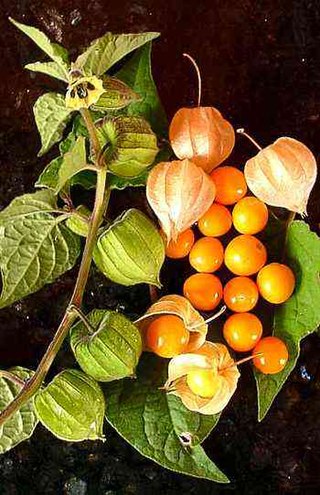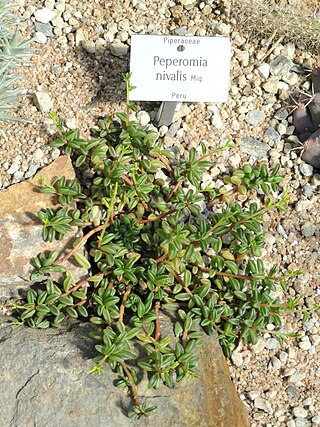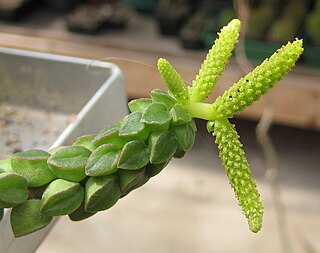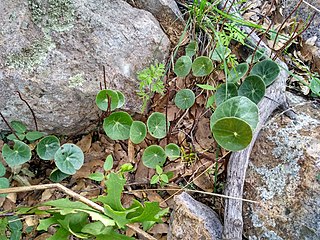
Peperomia is one of the two large genera of the family Piperaceae. It is estimated that there are at least over 1,000 species, occurring in all tropical and subtropical regions of the world. They are concentrated in northern South America and Central America, but are also found in Africa, southern Asia, and Oceania. The exact number is difficult to tell as some plants have been recorded several times with different names and new species continue to be discovered. Peperomias have adapted to many different environments and their appearance varies greatly. Some are epiphytes or lithophytes, and many are xerophytes (drought-tolerant) either with thick succulent structures or with underground tubers (geophytes). Most species are compact perennial shrubs or vines.

Physalis peruviana is a species of plant in the nightshade family (Solanaceae) native to Chile and Peru. Within that region it is called aguaymanto, uvilla or uchuva, in addition to numerous indigenous and regional names. In English, its common names include Cape gooseberry, goldenberry and Peruvian groundcherry.

Scilla peruviana, the Portuguese squill, is a species of Scilla native to the western Mediterranean region in Iberia, Italy, and northwest Africa. It is a bulb-bearing herbaceous perennial plant. The bulb is 6–8 cm in diameter, white with a covering of brown scales. The leaves are linear, 20–60 cm long and 1–4 cm broad, with 5-15 leaves produced each spring. The flowering stem is 15–40 cm tall, bearing a dense pyramidal raceme of 40-100 flowers; each flower is blue, 1–2 cm in diameter, with six tepals. The foliage dies down in summer, re-appearing in the autumn.

Peperomia graveolens is a species of plant in the genus Peperomia of the family Piperaceae. It is endemic to Ecuador.

Peperomia nivalis is a species of plant in the genus Peperomia endemic to Peru. Its native habitat is found in the high altitude ranges of the peruvian Andes. P. nivalis is a compact erect succulent herb with fleshy stems and leaves. The thick leaves are cuneate and U-shaped in cross-section with epidermal windows on the top-side. The leaf color is bright green in the shady summer and reddish during dry sunny seasons.

Peperomia columella is a species of plant in the family Piperaceae. The species is endemic to Peru. It grows in dry areas, often in crevices on steep cliffs or in sandy soil. It grows to about 20 cm in height, forming snake-like stems, which carry closely packed succulent bright green leaves. The leaves are truncated, U-shape in cross-section, with epidermal windows on top. It can be kept as a houseplant and has received the Award of Garden Merit by the Royal Horticultural Society.

Peperomia tetraphylla, known as the acorn peperomia or four-leaved peperomia, is a small plant in the Peperomia genus and the Piperaceae family that grows natively in tropical and subtropical regions around the world. Additionally in can found on Easter Island as an introduced species.

Peperomia obtusifolia, also known as the baby rubberplant, American rubber plant, or pepper face, is a species of flowering plant in the genus Peperomia under the family Piperaceae, native to Florida, Mexico and the Caribbean. The specific epithet obtusifolia means "blunt-leaved". The plant has gained the Royal Horticultural Society's Award of Garden Merit.
Gaultheria insipida, called chichaja in Spanish, is a flowering shrub of the plant genus Gaultheria. The species is native to the Andes; specimens have been found in Colombia, Ecuador, and Peru.

Peperomia alata, commonly known as the winged peperomia, is a species of plant in the genus Peperomia of the family Piperaceae. Its native range covers most of tropical and subtropical America, from southern North America through West Indies and Central America to South America. It can also be found in Florida, although there it is apparently rare, known for certain only from swamps in Collier County.

Peperomia ferreyrae is a species of plant in the genus Peperomia native to Peru. It is a small, succulent herb, growing erect to about 20 cm in height. The alternating, typically 3 to 5 cm long leaves, are in the form of tubes resembling green bean pods: U-shaped in cross-section with epidermal windows on the top-side.

Peperomia maculosa, commonly known as spotted-stalked peperomia and spotted peperomia, is a species of plant in the genus Peperomia. Its native range is from Mexico to northern South America.

Peperomia nitida is a species of plant in the genus Peperomia. Its native range is in South America from Brazil to northern Argentina. It can be kept as a houseplant and is sometimes sold as cupid peperomia, or problematically as Peperomia scandens or Peperomia serpens.
Peperomia macrorhiza is a species of plant in the genus Peperomia. It is endemic to Peru. It is a geophytic plant, storing water and reserves in an underground tuber. During dry periods parts above ground, such as leaves, will wither away but the plant will survive due to the tuber. When more rain falls the plant regrows its stalks and leaves on the surface.
Peperomia umbilicata is a species of plant in the genus Peperomia. It is endemic to Peru. It is a geophytic plant, storing water and reserves in an underground tuber. During dry periods parts above ground, such as leaves, will wither away but the plant will survive due to the tuber. When more rain falls the plant regrows its stalks and leaves on the surface.

Peperomia bracteata is a species of plant in the genus Peperomia. Its native range covers Mexico and Guatemala. It is a geophytic plant, storing water and reserves in an underground tuber. During dry periods parts above ground, such as leaves, will wither away but the plant will survive due to the tuber. When more rain falls the plant regrows its stalks and leaves on the surface.

Peperomia monticola is a species of plant in the genus Peperomia. It's endemic to Mexico. It is a geophytic plant, storing water and reserves in an underground tuber. During dry periods parts above ground, such as leaves, will wither away but the plant will survive due to the tuber. When more rain falls the plant regrows its stalks and leaves on the surface.

Peperomia magnoliifolia, commonly known as the spoonleaf peperomia, is a species of plant in the genus Peperomia. Its native range reaches from parts of southern Florida and Mexico to the Caribbean and northern South America including Uruguay.

Peperomia fraseri, commonly known as the flowering pepper, is a species of plant in the genus Peperomia of the family Piperaceae. Its native range covers Colombia and Peru. It has also been introduced to Ecuador and Guatemala.

Peperomia quadrangularis, commonly known as the beetle peperomia, is a species of plant in the genus Peperomia of the family Piperaceae. Its native range is in tropical America, including areas in northern South America, Central America and the West Indies.
















